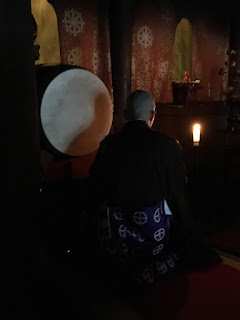How Many Sticks Do You Need For a Sacred Fire?
by Susan Spann
Writing historical mystery means balancing a fast-paced, often intricate plot with compelling, historically accurate details. To keep the plot moving, I often have to eliminate the bulk of my research--including many details I find intriguing. Occasionally, however, the decision what to keep and what ends up on the proverbial "cutting room floor" becomes more difficult.
Case in point: the Shingon Buddhist ceremonies in TRIAL ON MOUNT KOYA.
While researching the novel, I spent time on Koyasan, staying in thousand year-old Shingon temples and attending both worship services and the goma (fire ritual) that the priests still perform each morning just after dawn. As with most religious rituals, the goma involves detailed preparations, numerous books, bowls, and implements, and follows a carefully prescribed liturgical pattern. I discussed the ceremony with the priests, observed it closely, and took copious notes (and photographs, and video recordings) to ensure I understood it in detail.
As a result, the first draft of the goma scene in TRIAL ON MOUNT KOYA ran several pages--far too long--and I found myself debating exactly how many sticks I needed to build this particular sacred fire. On one hand, the goma is an integral part of Shingon worship. I needed the ritual in the book, both to create a realistic portrait of Shingon temple life in the 16th century and to advance some character-related elements of the plot. On the other hand, too much detail bogs down the pace and bores the reader. (Never a good idea.)
Deciding which details to keep, and which to cut, seemed difficult until I re-watched the video clips and reviewed my favorite photographs of the goma ceremonies I attended. The photos, in particular, captured the ritual's essence--flickering tongues of fire in a darkened room, the shadow of a Shingon priest on the drum that accompanied his chant, and the clouds of incense I could almost still feel coating the inside of my nose.
These sensory memories set a course for my editing. By focusing on my senses--especially what I heard and smelled--I stripped away the extraneous details, leaving what I hoped would convey the sights and sounds of a dramatic Shingon ritual, wherein wooden prayers are consumed by sacred fire and carried to heaven on incense-laden smoke. While remaining true, and accurate, in the details that remained, my scene no longer contained esoteric dogma, the Sanskrit words most readers would not understand, or heavily descriptive passages that did not advance the plot.
To my surprise, the scene did a better job of conveying the ritual after editing, even though I removed almost three-quarters of the original goma scene. Less really was more--more readable, more evocative, and more successful at conveying the drama and suspense of the fire ritual.
Apparently, you don't need all that many sticks to build a sacred fire after all.
**********
Susan Spann is the 2015 Rocky Mountain FIction Writers' Writer of the Year and the author of six novels in the Shinobi Mystery series. She has a degree in Asian Studies and a lifelong love of Japanese history and culture. She is currently spending a year in Japan, researching her next two novels and climbing Japan's most famous mountains for her first nonfiction book, 100 SUMMITS, scheduled for publication in 2020. She posts photos and stories about her travels in Japan at www.susanspann.com.
**********



















1 comment:
What a great post! Thank you so much for hosting Susan's guest post & blog tour, Julianne!
Amy
HF Virtual Book Tours
Post a Comment